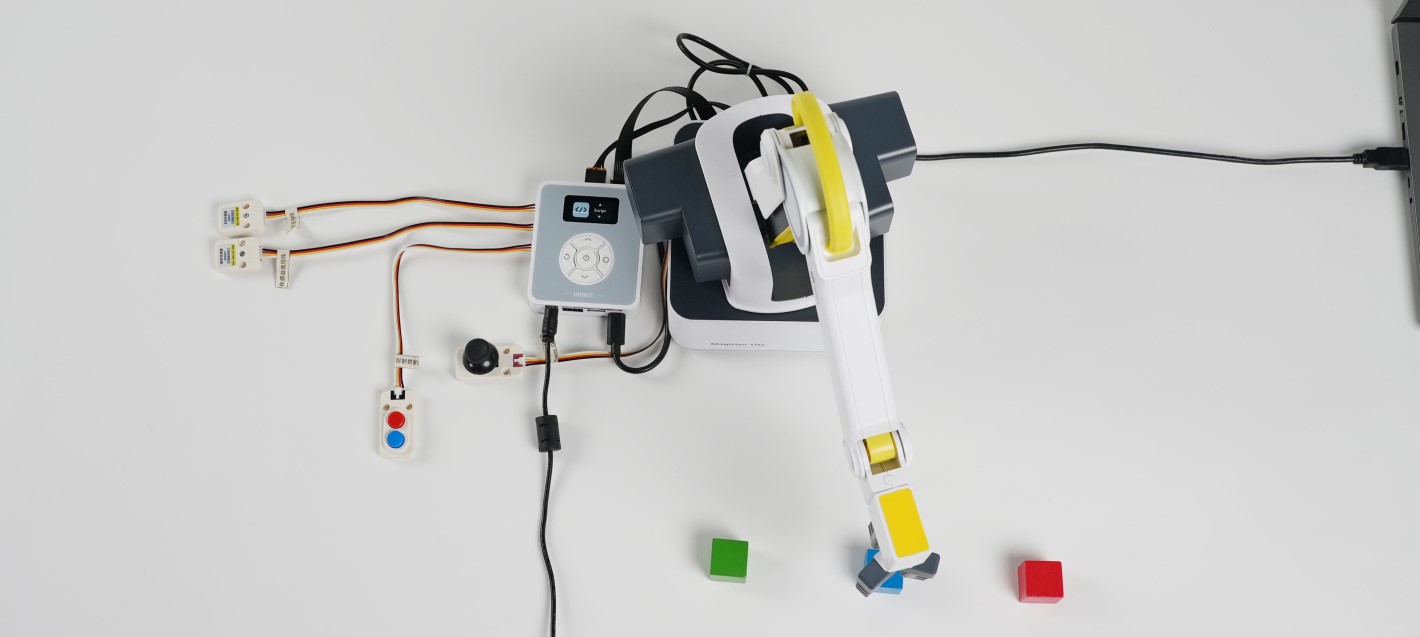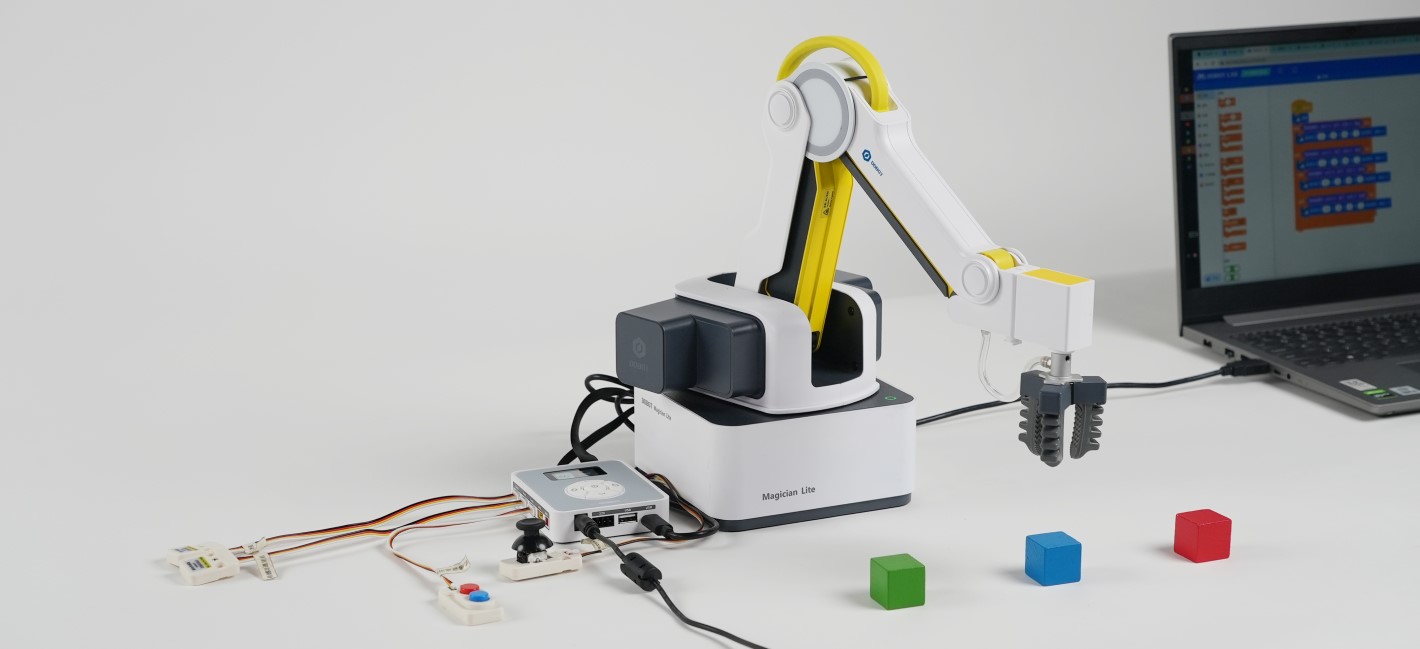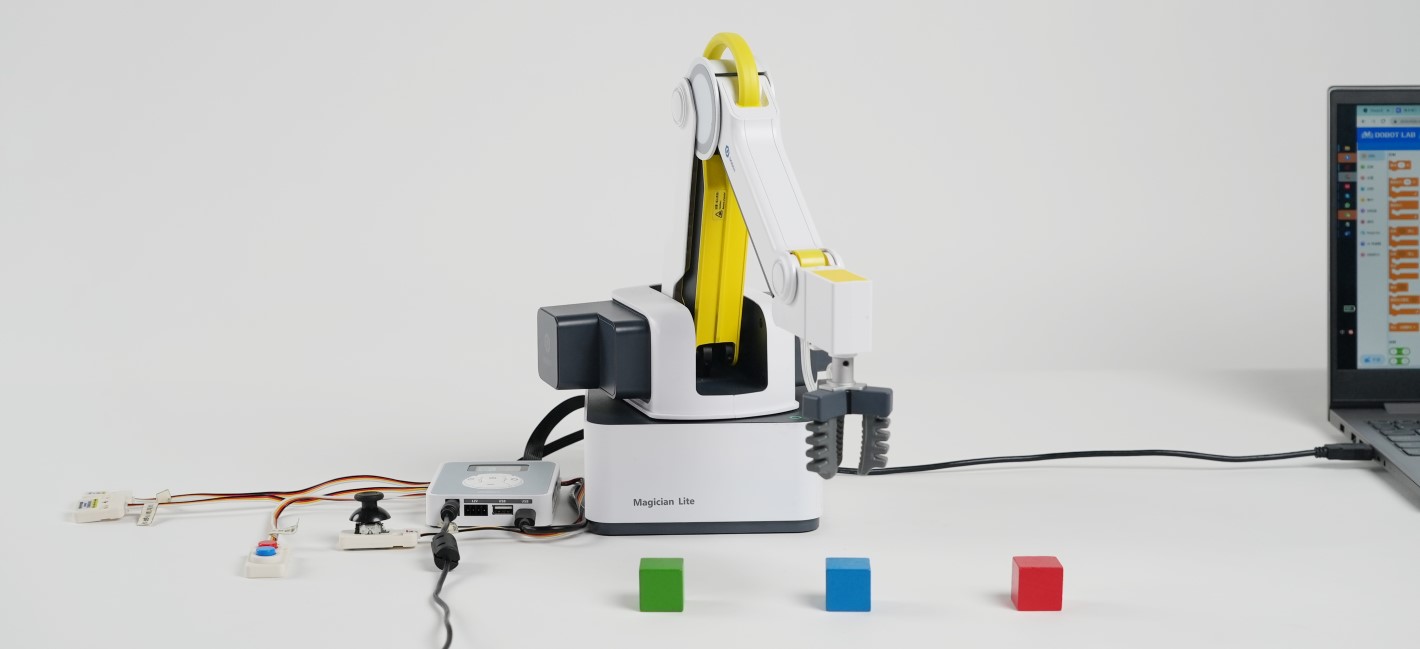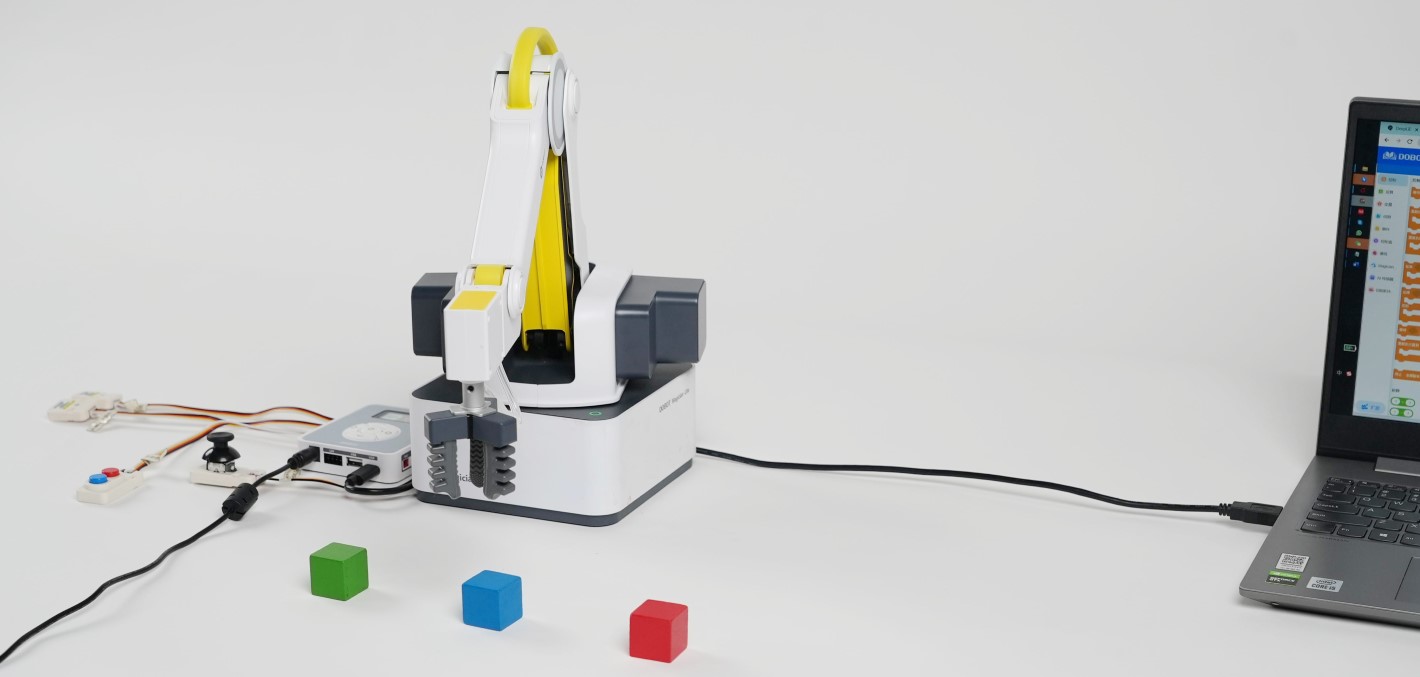Sense the tricks of automation
With the help of Dobot Magician LITE's accessory
Members of the desktop robot arm family include a rich software ecosystem, including the Python programming language and graphical programming. Their applications can be extended even further with the Sensor Kit. With the kit, you can experience working on input, joystick control and even AI-assisted positioning.
Engineering pratice
The sensors are capable of receiving a wide range of input signals, making Magician LITE's robotic arm suitable for simulating almost any automation operation in industry. By understanding the exact limits of the sensors, you can understand and apply the theoretical basis for assembling industrial automation processes.
The cables, the Magic Box and the sensor ports are colour-coded, so you can learn the most important element of engineering operations when using this kit: engineering design. Transparency is the basic measure of any good engineering. With colour coding, you can make it a routine task to build an easy-to-understand system using colour coding.
Logical thinking
With the Magic Box, the system can be deployed on a Block basis and using the Píthon programming language. DobotLab's documentation will help you to learn from the basics how the devices work and explore their programming possibilities.
Block-based programming (Blockly) helps to visualise the task execution capabilities of the robotic arm, while supporting the development of programming seedlings in a user-friendly way.
The Python programming language is one of the most popular choices among programmers. It is widely used to implement artificial intelligence, data processing, and automation processes. For an even more detailed programmability experience, Dobot has created its own Python library that makes the robot arm and all the sensors in the package programmable. The big challenge comes with a big reward, because by using it, you will not only learn how to program the robotic arm, but also how to apply the syntax of the Python programming language, which will allow you to take the first step towards creating your own artificial intelligence.




Parameters
Joystick
| Communication mode | I2C |
| Cable | Universal Sensor Cable |
| X/Y output (Stick movement left/right - up/down) values | 10 - 250 |
| Z output (Stick press) | 0 (released); 1 (pressed) |
| Voltage | 5V |
| Curent | 50mA |
Dual buttons
| Communication mode | IO |
| Cable | Universal Sensor Cable |
| Voltage | 5V |
| Output value of buttons | 0 (released); 1 (pressed) |
| Current | 50mA |
PIR Sensor
| Communication mode | IO |
| Cable | Universal Sensor Cable |
| Detection distance | 150cm |
| Delay period | 2s |
| Induction distance | <100° |
| Static Current | <60uA |
| Operating temperature | -20 ~ 80°C |
| Voltage | 5V |
| Current | 50mA |
Gesture Sensor
| Communication mode | I2C |
| Cable | Universal Sensor Cable |
| Supported gestures | Up, down, right, left, forward, backward, clockwise, counterclockwise |
| Effective detection distance | 5 - 15cm |
| Voltage | 5V |
| Current | 50mA |
Photoelectric Sensor
| Communication mode | IO |
| Cable | Universal Sensor Cable |
| Value-range | 0 (no shield); 1(with shield) |
| General detection environment | Sunlight lower than 10000LX, Bulb lower than 3000LX |
| Object to be detected | Transparent or opaque |
| Operating temperature | -25 ~ 55°C |
| Response time | <2ms |
Sound Sensor
| Communication mode | ADC |
| Cable | Universal Sensor Cable |
| Value-range | 0 ~ 1023 |
| Sensitivity | (48dB ~ 52dB) @ 1kHz |
| Microphone impedance | 2.2k ohm |
| Microphone frequency | 16 ~ 20 kHz |
| SNR S/N | 54dB |
Humiture Sensor
| Communication mode | I2C |
| Cable | Universal Sensor Cable |
| Temperature-range | 0 ~ 60°C/±1°C |
| Humidity-range | 10 ~ 90% RH ±5%RH |
| Voltage | 5V |
| Current | 50mA |
Color Sensor
| Communication mode | I2C |
| Cable | Universal Sensor Cable |
| Color recognition mode | 0 (no color); 1 (red); 2 (green); 3 (blue); 4 (yellow); 5 (black); 6 (white) |
| RGB colour values | 0-200 (higher value indicates a darker colour) |
| Voltage | 5V |
| Current | 50mA |
LED modul
| Communication mode | Monobus |
| Cable | Universal Sensor Cable |
| RGB values | 0 ~ 100% |
| Voltage | 5V |
Light Sensor
| Communication mode | I2C |
| Cable | Universal Sensor Cable |
| Color recognition mode | 0 (no color); 1 (red); 2 (green); 3 (blue); 4 (yellow); 5 (black); 6 (white) |
| RGB colour values | 0-200 (higher value indicates a darker colour) |
| Voltage | 5V |
| Current | 50mA |
Knob Potentiometer
| Output Voltage | 0 ~ 2500mV |
| Communication mode | ADC |
| Cable | Universal Sensor Cable |
| Return rate | 0 ~ 407 (extreme fluctuation is normal) |
| Voltage | 5V |
| Current | 50mA |
Microservo motor
| Communication mode | PWM |
| Cable | Universal Sensor Cable |
| Servo speed | 0.1mp/60°/4.8V; 0.09mp/60°/6.0V |
| Torque | 1.6kg*cm/4.8V; 1.8kg*cm/6.0V |
| PWM frequency | 50Hz/0.5~2.5MS |
| Voltage | 4.8V - 6.0V |
| No load curent | 60mA |
Content of package
- 1db Joystick
- 1db Dual button
- 1db PIR sensor
- 1db Gesture sensor
- 1db Photoelectric sensor
- 1db Sound sensor
- 1db Humiture sensor
- 1db Color sensor
- 1db LED modul
- 1db Light sensor
- 1db Knob potentiometer
- 1db Microservo motor
